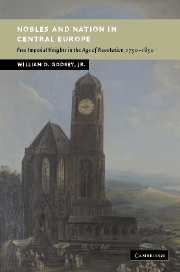Book contents
- Frontmatter
- Contents
- Preface
- Abbreviations
- Introduction
- 1 Wealth and noble autonomy: the Free Imperial Knights in Mainz on the eve of revolution
- 2 Nobles becoming Germans: the transformation of a concept
- 3 Nobles becoming Germans: the destruction of a “geo-cultural landscape”
- 4 Between destruction and survival: knights on the Middle Rhine 1750–1850
- 5 The past recaptured: knights in the Hapsburg Empire 1792–1848
- 6 From cathedral canons to priests: the Coudenhoves and the “Catholic revival”
- 7 The beginnings of conservative German nationalism: the “naturalization” of Baron Carl vom und zum Stein (1757–1831)
- Conclusion
- Appendix: Families of Free Imperial Knights (1797)
- Bibliography
- Index
4 - Between destruction and survival: knights on the Middle Rhine 1750–1850
Published online by Cambridge University Press: 01 October 2009
- Frontmatter
- Contents
- Preface
- Abbreviations
- Introduction
- 1 Wealth and noble autonomy: the Free Imperial Knights in Mainz on the eve of revolution
- 2 Nobles becoming Germans: the transformation of a concept
- 3 Nobles becoming Germans: the destruction of a “geo-cultural landscape”
- 4 Between destruction and survival: knights on the Middle Rhine 1750–1850
- 5 The past recaptured: knights in the Hapsburg Empire 1792–1848
- 6 From cathedral canons to priests: the Coudenhoves and the “Catholic revival”
- 7 The beginnings of conservative German nationalism: the “naturalization” of Baron Carl vom und zum Stein (1757–1831)
- Conclusion
- Appendix: Families of Free Imperial Knights (1797)
- Bibliography
- Index
Summary
“The nobility is important as the upholder of the continuity of the nation.”
Count Edmund Kesselstatt, “Skizze den Adel betreffend,” 1818, StadtA Trier, Kesselstatt Papers, no. 5515.The original geographical dispersion of the knightly families represented in Mainz's cathedral chapter — from Swabia, Franconia, and the Rhineland — meant that they experienced the years after 1792 in very different ways. This was merely accentuated, as we shall later see, by the revolutionary emigration of a large proportion of them. Though the eighteenth century had seen immediate imperial nobles extend their reach into chapters and collegiate foundations far beyond their home regions, the Rhenish preponderated at Mainz to the end. The discussion below addresses the problem, down to 1848, of those knights who ultimately remained in the Rhineland, who experienced the loss of the old “geo-cultural landscape,” and who in the accustomed surroundings had to come to terms with the catastrophic material consequences of the destruction of the imperial constitution (Reichsverfassung). The revolution shattered an order in which two of its pillars, nobility and Church, had been inextricably intertwined and in which each had guaranteed the other's existence. With Electoral Mainz foremost among them, the great ecclesiastical states exemplified the advantages of the system of prebends, the heart of the old affiliation, for the Free Imperial Knights that dominated them. Knightly families of pedigree typically produced large numbers of children to ensure their survival. One son inherited the ancestral estates, while his brothers were compensated in the Church.
- Type
- Chapter
- Information
- Nobles and Nation in Central EuropeFree Imperial Knights in the Age of Revolution, 1750–1850, pp. 106 - 140Publisher: Cambridge University PressPrint publication year: 2004

